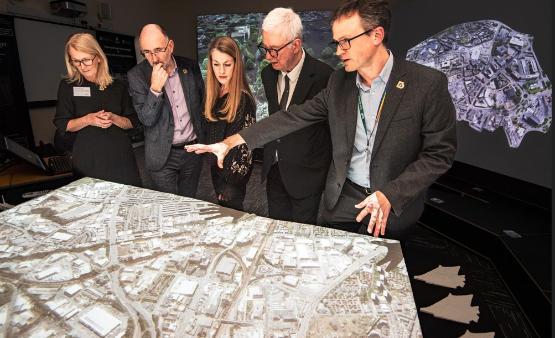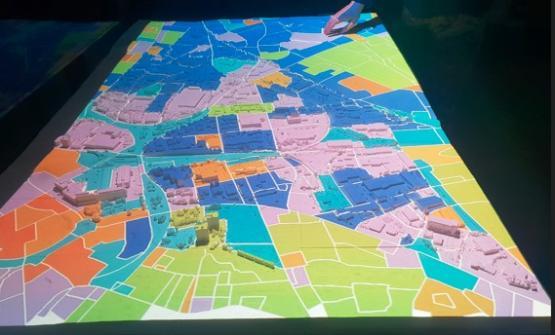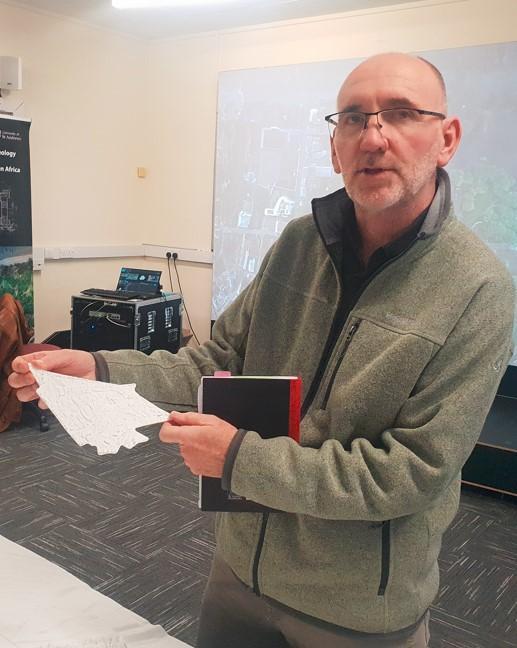Model city of culture
Bradford stands on the cusp of a new era, thanks to a multi-million-pound investment in its city centre, the spirit of Bradford 2025 UK City of Culture and early signs its Clean Air Zone is having a real impact on people’s health. But it is a model city in more ways than one...

Tucked away in a darkened room on one of the upper floors of the University of Bradford’s main Richmond Building a 3D scale model of Bradford’s Southern Gateway glows in the light of a projector.
The model, printed using polymer-based starch, is a brick-for-brick replica of a vast swathe of land that is ripe for development and which also happens to be the preferred location for a new rail station, should the Government be minded to approve the scheme.

What is significant about the model (pictured above as on a scale of 1:1250) is that it represents a new way of thinking about place and urban planning (and, indeed, community engagement).
The model was made possible thanks to an initiative known as Virtual Bradford, the UK’s first open-source digital twin (across a variety of Council and University-led projects, drawing upon funds from the European Union, the Ministry of Housing, Communities & Local Government and the Arts and Humanities Research Council). The data was captured using airborne, back-pack and vehicle-mounted systems to capture detail down to the millimetre scale. As a tool for communicating the potential of urban places, it is even possible to project live traffic data onto the model, so that you can see buses, trains and cars moving along its thoroughfares.
Indeed, the project has been so successful that the University is expanding Virtual Bradford and developing virtual models for other cities in the UK and overseas. Bradford Council is already using Virtual Bradford to help manage the UNESCO World Heritage Site of Saltaire; to see what planning applications would actually look like (both One City Park and Darley Street Market existed in the virtual model long before they did in the real world); and to model things like air pollution.
Speaking of which, new research funded by the National Institute for Health and Care Research (NIHR), suggests Bradford Clean Air Plan (B-CAP) is already reducing breathing related visits to GPs.
Although the study runs for another two years, the interim report found there were 598 fewer GP visits for respiratory health and 134 fewer visits for cardiovascular health each month, reducing the burden on GP practices and saving the NHS an estimated £30,743 per month.
Professor Andrew Wilson, from the University’s School of Archaeology and Forensic Sciences, said: “Are models like this going to be used by the Council to make decisions on things like the Clean Air Zone in future? Absolutely. The digital twin technologies that we are using to extend Virtual Bradford are extremely versatile. The way that the data is classified means that artificial intelligence can help us to understand the landscape, so for example, we can strip out all the cars and remove all the buildings to just leave the greenspaces. This is about storytelling and placemaking. It’s about taking an area of the city and using that to create a narrative that drives engagement. At the end of the day, this is about people and the potential for understanding what makes healthy urban places.”

Above: Professor Chris Gaffney holding a 1:10,000 scale model of Bradford's Southern Gateway
People and place
As the city prepares for Bradford 2025 UK City of Culture, and with the imminent opening of Bradford Live and a newly pedestrianised city centre, the birth of Virtual Bradford feels almost prophetic. The University of Bradford, long recognised for its prowess as a hive of research and innovation and a centre of scientific excellence, has suddenly found itself a standard bearer for a cultural revival.
Its academics helped massively in the successful bid process by submitting quantifiable data to support the Bradford Bid aims; they will be involved in monitoring and evaluating various City of Culture events, including using new ‘anonymous crowd monitoring technology’, and they will be an integral part of helping ensure Bradford 2025 leaves a tangible legacy.
They will also lead a series of City of Culture-themed events, from use of archaeology to uncover evidence of the 1904 Bradford Exhibition, which attracted 2.5 million visitors to one of the City’s first major cultural festivals, through to performances at the University’s on-campus Theatre in the Mill.
The University recently hosted the third annual Key Cities Innovation Network, a consortium of universities and councils focused on urban renewal. In her opening address, University Vice-Chancellor Professor Shirley Congdon said: “Our partnership with Bradford 2025 UK City of Culture is of strategic significance to us and the city as we embed opportunities for economic and social growth.
“Using Virtual Bradford, we have mapped heritage and iconic cultural sites to understand ‘place-making’ in Bradford. The 3D models are used for understanding the effect of proposed planning changes; they can be used to model data to show air quality and flood mitigation and have many other potential uses. But perhaps one of its most important functions is that it enables us to tell stories, to create narratives, to engage communities in dialogue.”
